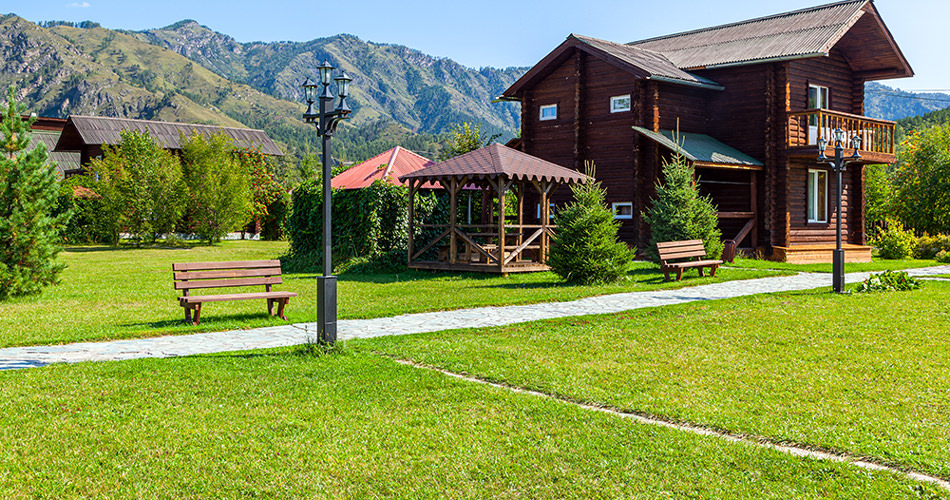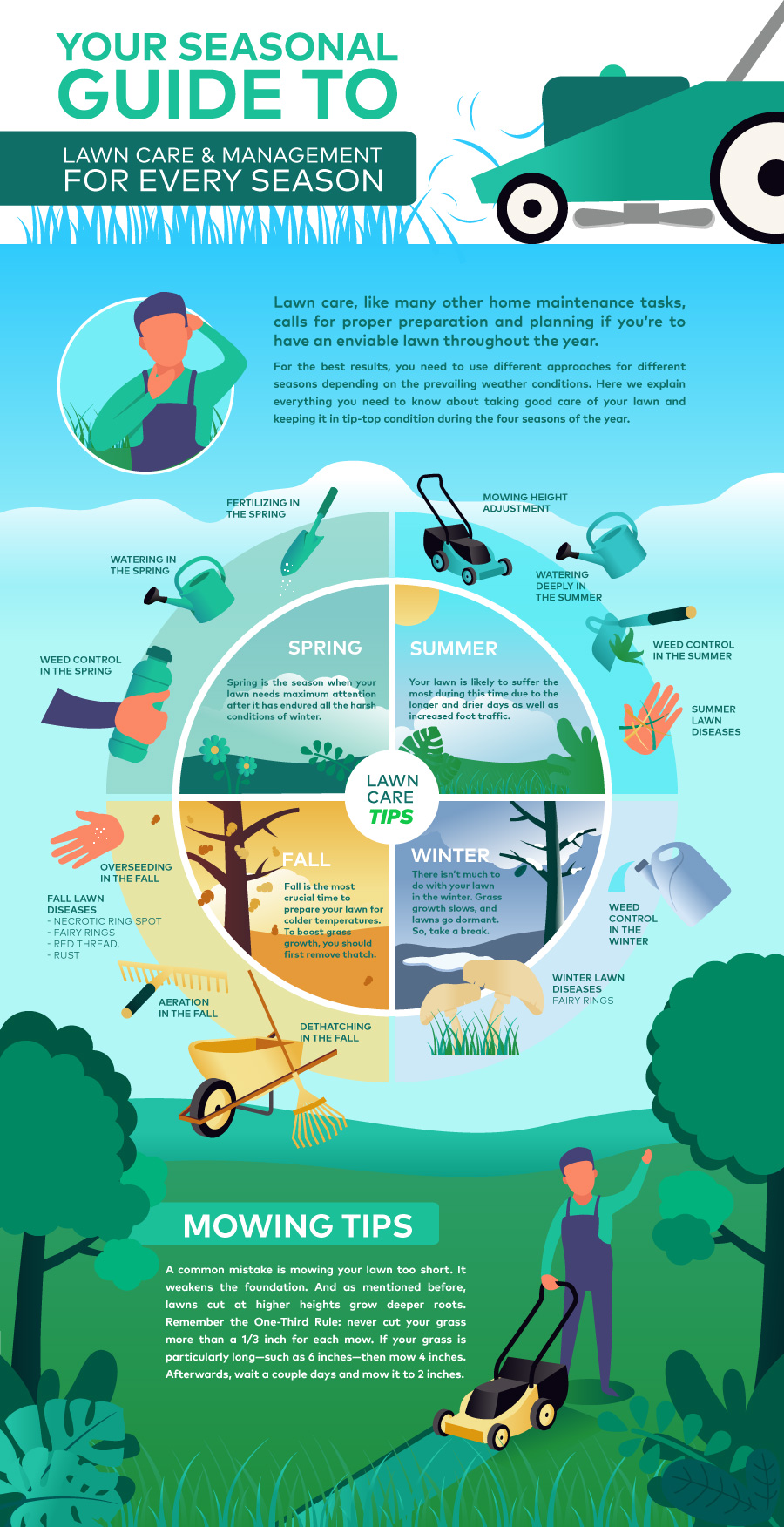
A nicely maintained lawn in your back or front yard of your house gives scenic happiness after a tiring day end work to release all negative energies throughout the day into empty space. Gardening and lawn caring are the most commonly chosen hobbies by many stay-at-home moms and dads to keep themselves occupied during the daytime of loneliness in the house filled with chatter at night. Dealing with natural weather conditions to maintain a quality lawn is an arduous task. But knowing how to care for your lawn in each season helps to keep it in good condition to survive throughout the seasons. Let me take you through a brief lawn care guide suiting for all four seasons.
Summer
Beginning with the season currently, we face, summer is not a season that goes much hand in hand with a good lawn due to various reasons. It’s a season most of us look forward to going on outdoors and enjoy with a nice bright sunbath on the scorching beach. Kids are on top of the world with many outdoor games being played whilst parents have their own wish list! With a lot of outdoor activities happening during this period, your lawn is likely to get probed to more trampling and foot traffic and you may not be at home to personally take care of your lawn from drier days due to summer vacations. But you could still give the lawn a pampering much required to minimize damages caused by summer activities. Summer is an ideal time to mow the lawn and adjust the height accordingly. It allows you to gradually prepare the lawn for upcoming seasons. Controlling your lawn from harmful weeds is best to be done during summer as the heat waves likely to support you with it. However, your lawn needs lots and lots of water during summer as the sun’s going to evaporate as much as water you put over the lawn. Also, your lawn will suffer from summer patch diseases, where fungi create a circular tan-brown patch in the lawn when the turfgrass grows slower. Natural preventive measures such as keeping lawn grass pH levels at an appropriate level, proper fertilizing, mowing, and watering practices keep your lawn safe from summer patches.
Fall
During fall, your time available to take care of the lawn could be limited, but it still needs a lot of attention to get itself prepared for colder temperatures in winter. The lawn grass requires extra care for growth during the fall. This is the period you rejuvenate your lawn from its roots. Hence you could first start by dethatching the lawn to remove dead materials using a metal leaf rake. Removing thatch is successful when your lawn is actively growing and the soil is moist. Thereafter aerate your lawn allowing it to absorb air, water, and other nutrients that help the roots to grow deeply and attract oxygen for worms, microfauna, and flora in the lawn. Aerating involves forming tiny holes on the grass that expedite the absorption process. Thereafter overseed tour lawn by sprinkling new grass seeks to fill in areas of thinning turf. Overseeding during fall is a convenient option to achieve a healthy, thick green grass. Your lawn also encounters diseases during the fall such as red thread, rust, fairy rings, goosegrass, and necrotic ring spot. These diseases could be prevented by following stipulated guidelines when fertilizing especially. Moreover, if your lawn is too shady diseases such as rust could occur more often. However, you could grow a shade-tolerant grass or prune branches of the shading tree to allow more sunlight to the lawn. This also helps get rid of the moss in lawns.
Winter
Season of love and togetherness so does your lawn will fall to sleep during this period. Taking care of your lawn during this period minimal as grass growth slows and probably your lawn is trying to protect itself from snow during this period. Hence you could only keep the lawn surviving and controlled from weeds during winter. Due to moist conditions, the lawn is probed for snow mold and fairy ring diseases. Winter lawn caring is begun before the season by lawnmower the grass to a shorter length to avoid rodents taking shelter in the cold season. Before winter hits, aerate the soil and fertilize to keep itself ready for damaging weather conditions. During winter it is important to avoid foot traffic on lawns by pass byers who walk over your lawn due to snow on pavements. Importantly keeping your lawn cleaned from branches and leaves helps it to remain moderately stable in high humid temperatures.
Spring
Yet another season your lawn requires more of your attention and pamper as a reward for enduring harsh weather conditions in winter. During spring you could begin by raking your lawn removing the fall leaves that dried during winter. Your lawn requires complete treatment similar to activities in fall. Fertilizing the soil back again during spring is crucial to invigorate dead materials in the lawn, thereby water it adequately not forgetting the soil may still have humidity from winter and necessary weed control. Spring sets the mood for the summer lawn. The pH level of your soil that got altered in winter, compacted and created a favorable condition for weeds and diseases, hence proper cleaning, fertilizing, and lawnmower the yard is important to bring your lawn back on track. Whilst some opt to use herbicides over weed control to gain healthy lawn growth. There are pre-emergent and post-emergent herbicides that could be decided based on whether your lawn’s weed is annual or perennial.
Consequently, an all-year-round lawn care guide has a couple of predominant tips, where watering the lawn, fertilizing, and weed control are essential vitamins to your lawn. Make sure to take care of your lawn equally all throughout the year especially not abandoning during winter when the lawn is dormant. The following infographic below portrays a pictorial presentation of the above-discussed lawn care guide in summary, which gives a better understanding of your next gardening session.






1 Comment
Clifford
I appreciate you mentioning some amazing maintenance tips about proper lawn care care that I don’t know about outside of mowing
and trimming the yard. Thanks for sharing wonderful information.